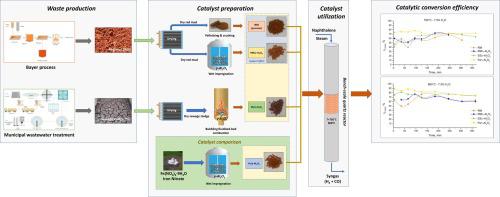当前位置:
X-MOL 学术
›
Waste Manag.
›
论文详情
Our official English website, www.x-mol.net, welcomes your feedback! (Note: you will need to create a separate account there.)
Waste-derived catalysts for tar cracking in hot syngas cleaning
Waste Management ( IF 8.1 ) Pub Date : 2024-03-12 , DOI: 10.1016/j.wasman.2024.03.006 Francesco Parrillo , Filomena Ardolino , Carmine Boccia , Vincenzo Arconati , Giovanna Ruoppolo , Umberto Arena
Waste Management ( IF 8.1 ) Pub Date : 2024-03-12 , DOI: 10.1016/j.wasman.2024.03.006 Francesco Parrillo , Filomena Ardolino , Carmine Boccia , Vincenzo Arconati , Giovanna Ruoppolo , Umberto Arena

|
Catalytic tar cracking is a promising technique for hot syngas cleaning unit in gasification plants because it can preserve tars chemical energy, so increasing the syngas heating value. The cost associated with catalyst preparation is a key issue, together with its deactivation induced by coke deposition. Iron is a cheap and frequently used catalyst, which can also be found in some industrial wastes. The study aims to assess the catalytic efficiency for tar cracking of two waste-derived materials (red mud and sewage sludge) having high content of iron. The catalysts were supported on spheres of γ-AlO, and their efficiency was compared to that of a pure iron catalyst. The role of support was investigated by testing pure red mud, with and without the support. A series of long-term tests using naphthalene as tar model compound were carried out under different values of process temperatures (750 °C-800 °C) and steam concentrations (0 %-7.5 %). The waste derived catalysts showed lower hydrogen yields compared to pure iron catalyst, due to their lower content of iron. On the other hand, the conversion efficiencies of all the tested catalysts resulted rather similar, since the Alkali and Alkaline-Earth Metallic species present on the surface of waste-derived catalyst help in preventing coke deposition. The iron oxidation state appears to play an important role, with reduced iron more active than its oxidised form in the tar cracking reactions. This indicates the importance of tuning steam concentration to keep constant the reduced state of iron while limiting coke deposition.
中文翻译:

用于热合成气净化中焦油裂解的废物衍生催化剂
催化焦油裂解是气化厂热合成气净化装置中一项很有前途的技术,因为它可以保存焦油化学能,从而提高合成气热值。与催化剂制备相关的成本以及焦炭沉积引起的失活是一个关键问题。铁是一种廉价且常用的催化剂,在一些工业废物中也可以找到。该研究旨在评估两种铁含量高的废物衍生材料(赤泥和污水污泥)的焦油裂解催化效率。该催化剂负载在 γ-Al2O3 球体上,并将其效率与纯铁催化剂进行比较。通过测试有和没有支撑的纯赤泥来研究支撑的作用。以萘为焦油模型化合物,在不同的工艺温度(750℃-800℃)和蒸汽浓度(0%-7.5%)下进行了一系列长期测试。由于铁含量较低,与纯铁催化剂相比,废物衍生催化剂的氢产率较低。另一方面,所有测试催化剂的转化效率结果相当相似,因为废物衍生催化剂表面上存在的碱金属和碱土金属物质有助于防止焦炭沉积。铁的氧化态似乎起着重要作用,在焦油裂解反应中,还原态铁比氧化态铁更活跃。这表明调节蒸汽浓度以保持铁的还原态恒定同时限制焦炭沉积的重要性。
更新日期:2024-03-12
中文翻译:

用于热合成气净化中焦油裂解的废物衍生催化剂
催化焦油裂解是气化厂热合成气净化装置中一项很有前途的技术,因为它可以保存焦油化学能,从而提高合成气热值。与催化剂制备相关的成本以及焦炭沉积引起的失活是一个关键问题。铁是一种廉价且常用的催化剂,在一些工业废物中也可以找到。该研究旨在评估两种铁含量高的废物衍生材料(赤泥和污水污泥)的焦油裂解催化效率。该催化剂负载在 γ-Al2O3 球体上,并将其效率与纯铁催化剂进行比较。通过测试有和没有支撑的纯赤泥来研究支撑的作用。以萘为焦油模型化合物,在不同的工艺温度(750℃-800℃)和蒸汽浓度(0%-7.5%)下进行了一系列长期测试。由于铁含量较低,与纯铁催化剂相比,废物衍生催化剂的氢产率较低。另一方面,所有测试催化剂的转化效率结果相当相似,因为废物衍生催化剂表面上存在的碱金属和碱土金属物质有助于防止焦炭沉积。铁的氧化态似乎起着重要作用,在焦油裂解反应中,还原态铁比氧化态铁更活跃。这表明调节蒸汽浓度以保持铁的还原态恒定同时限制焦炭沉积的重要性。



























 京公网安备 11010802027423号
京公网安备 11010802027423号